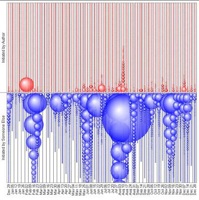Future Now
The IFTF Blog
Mapping cyberspace
"

The current issue of The
The current issue of The Chronicle of Higher Education features an engaging article about how social scientists are creating visual maps to study connections, linkages and interpersonal interactions in cyberspace. The article was pegged on The Hyperlinked Society, a transdisciplinary conference that took place this month to examine online "links and their impact on the ways people think and talk about their worlds." Video of the proceedings are here.
According to The Chronicle's article, companies like Microsoft and Nielsen BuzzMetrics, are increasingly using maps to analyze online culture for business purposes. At left above is a map of 1,000 or so of the most popular blogs mapped by Nielzen Buzzmetrics' Matthew Hurst. His blog has more examples. At right is a map from Microsoft Research of online conversations. From The Chronicle:
"The future of computing is social computing," said Marc A. Smith, leader of the Community Technologies group at Microsoft Research, at the conference here. "The question is how do you harness the swarm."
He has been working on a project called Netscan, which analyzes behavior on Usenet, a text-only online discussion forum that has been around since before the invention of the World Wide Web. Though Usenet is far less popular than blogging these days, Mr. Smith says the forum can yield important lessons that can be transferred to newer online discussion spaces that use so-called "threaded messages," where conversations are organized by topic.
"What we're trying to do is show patterns of contribution to threaded conversation communities," Mr. Smith says.
The project generates plenty of raw data tables ripe for analysis. But Mr. Smith says the visual representations of data are far more powerful for spotting patterns. "Like a lot of people, I'm not that numerate, and the pictures speak to me in a way that tables of numbers do not," says Mr. Smith.
In fact, Mr. Smith and his colleagues have developed a way to determine what kind of user a person is by looking at data maps of their posting behavior rather than examining the content of their messages. Among the type of users: the "answer person," who is quick to provide advice to strangers; the "flame warrior," who enters discussions hoping to win arguments by trashing other participants; the "discussion person," who is willing to talk on just about any topic; and "the questioner," who seeks advice but is not a frequent participant and is not looking for conversation.
Several weeks' worth of activity by a single user can be shown on one visualization, where each new discussion thread the user participated in is shown as a bubble, and the size of the bubble represents the number of times the user posted on that topic.
"Our intent has been to make visible the latent but invisible patterns in conversational data sets," said Mr. Smith and several colleagues in a report on the research.



